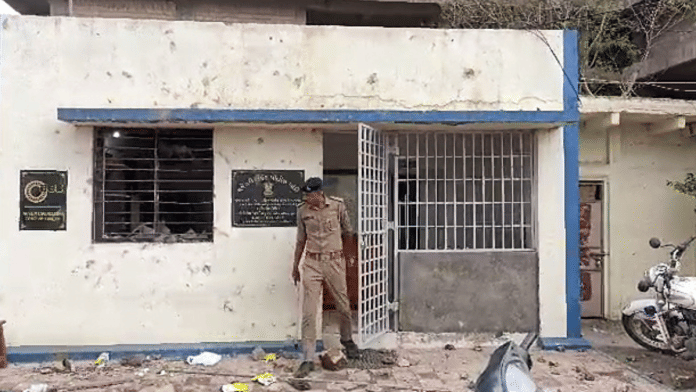New Delhi: In a recent significant judgment, the Supreme Court has addressed the complex application of Section 149 of the erstwhile Indian Penal Code (IPC) by drawing a distinction between presence and participation to convict those involved in unlawful assembly.
The Section holds every member of an unlawful assembly (five or more persons) guilty of an offence committed by any member in the prosecution of the assembly’s common object, or for an offence that members knew was likely to be committed.
Additionally, it establishes a form of vicarious liability, wherein an entire group can be held responsible for an individual’s act if it was linked to their shared unlawful purpose.
On Monday, a bench of Justices J.B. Pardiwala and R. Mahadevan laid down a seven-factor test to determine when a person’s presence at a crime scene amounts to participation in an unlawful assembly.
The judgement reiterating the need for stringent judicial scrutiny to protect innocent bystanders was delivered when the top court acquitted 10 people, who were convicted for their alleged role in a 1988 clash in Bihar’s Katihar district. Two people were killed and several injured in this episode.
The prosecution, it found, had failed to establish that the group shared the “common object” of the mob.
The case prompted the court to revisit earlier precedents that define the limits of constructive liability and the evidentiary safeguards necessary in cases involving mass implication.
“Where general allegations are leveled against many individuals, courts must exercise extreme care and look for cogent, credible material before accepting the prosecution’s version,” the bench observed Wednesday in a 75-page ruling, emphasising that “constructive liability must not be applied mechanically in mob violence cases.”
Also Read: 2012 Jama Masjid rioting case: Why a Delhi court let 16 men walk free
The rule of common object
When it comes to Section 149 of IPC, determining what constitutes a “common object” is one of the most debated questions in criminal jurisprudence. The courts have repeatedly underlined that mere presence at the scene does not amount to guilt—the accused must be shown to have actively shared the unlawful intent or participated in furthering it.
The Supreme Court’s 7 October verdict builds upon a long line of rulings that have refined and narrowed the scope of Section 149, moving from broad collective culpability to a more cautious, evidence-based approach.
In the Mizaji vs State of Uttar Pradesh (1958) case, the SC adopted an expansive interpretation, holding that when a group of armed men sets out to forcibly take possession of land, it can be reasonably inferred that they shared the knowledge that murder was likely to occur. Collective intent, rather than individual action, was deemed sufficient for liability.
However, the court introduced caution in the Masalti vs State of Uttar Pradesh (1964) case, ruling that convictions under Section 149 should be supported by the consistent testimony of two or more reliable witnesses, not sweeping generalisations. It clarified that mere presence in a large assembly cannot justify conviction unless participation or a common object is proved through credible evidence.
Similarly, the apex court in the Muthu Naicker v. State of Tamil Nadu (1978) case held that a witness’s testimony in mob cases must be carefully scrutinised and corroborated, stressing that a person’s mere presence at the scene does not automatically make them part of an unlawful assembly unless their conduct clearly reflected a shared intent.
Later, in the Sherey v. State of Uttar Pradesh (1991) case, the Supreme Court reiterated that in mob prosecutions, evidence must be examined against early records like the FIR, and convictions should be confined to those consistently named from the beginning, which was a safeguard against false implication in cases with omnibus allegations.
The modern framework was cemented in the Subal Ghorai & Ors. vs State of West Bengal (2013) case, where the court emphasised that judges must undertake a “difficult and meticulous exercise” to distinguish between actual participants and innocent bystanders. It warned that constructive liability “cannot be stretched to rope in the innocent,” reaffirming the importance of individualised assessment in group offences.
A structured safeguard
The latest 2025 ruling reinforces these principles through its structured seven-factor test, requiring courts to examine the nature of the assembly, weapons carried, conduct before and after the incident, and whether each accused shared the common object at every stage.
By reasserting that mere presence does not amount to guilt, the Supreme Court has reaffirmed the constitutional balance between collective responsibility and individual justice—a doctrine shaped and sharpened through decades of judicial reflection.
The top court laid down a seven-factor test to determine whether a bystander or onlooker shares a common object with the unlawful assembly.
The factors include time and place at which the assembly was formed; the conduct and behaviour of its members at or near the scene of the offence; the collective conduct of the assembly, as distinct from that of individual members.
The motive underlying the crime; the manner in which the occurrence unfolded; the nature of the weapons carried and used; and the nature, extent, and number of the injuries inflicted, and other relevant considerations are the other prerequisites.
“This cautionary rule, however, does not dilute the doctrine of constructive liability, under which proof of an overt act by each individual is not indispensable. Where the presence of a large number of persons is established and many are implicated, prudence mandates strict adherence to this rule of caution,” the bench held.
(Edited by Tony Rai)
Also Read: A Rajasthan king’s estate goes to Khetri trust, just as he wanted. Inside the 40-yr battle royale






